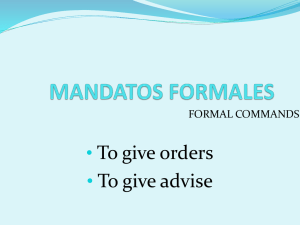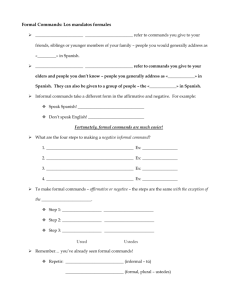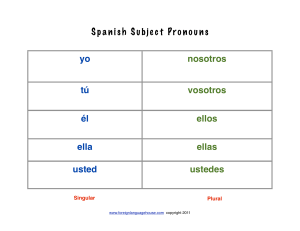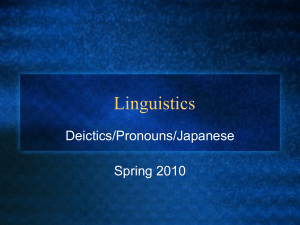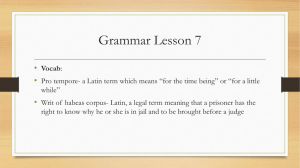Realidades 2 - Bienvenidos a las clases de la Sra. Mardos
advertisement
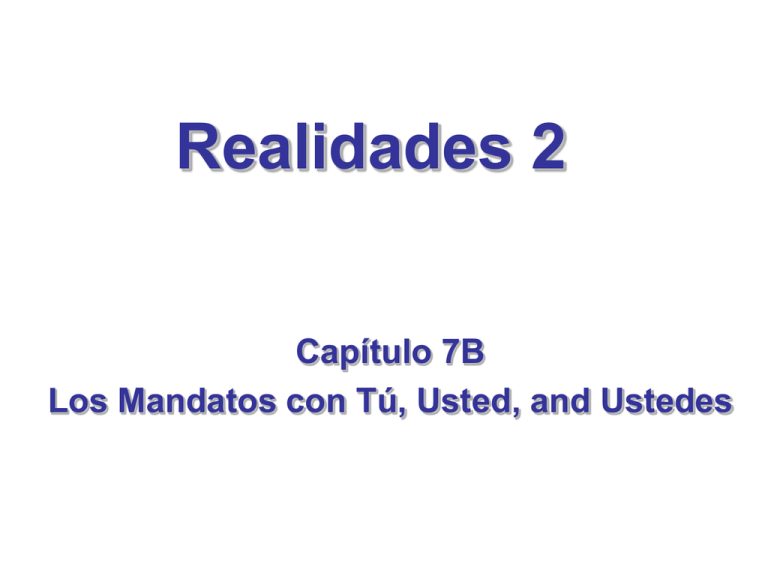
Realidades 2 Capítulo 7B Los Mandatos con Tú, Usted, and Ustedes I.First, let’s review the object pronouns – reflexive, indirect, and direct. A. Reflexive Pronouns / Los Pronombres Reflexivos These pronouns are required every time you use a reflexive verb. In Spanish, the reflexive verb implies the subject does the action to himself. me myself nos ourselves te yourself (familiar singular) os yourselves (familiar plural, used in Spain) se himself, herself, oneself, se themselves, yourselves (polite plural) itself, yourself (polite singular) B. Indirect Object Pronouns / Los Complementos Indirectos Indirect objects ask the questions To whom? or For whom? me to (for) me te to (for) you (familiar singular) le to (for) him, her, it, you (polite singular) nos to (for) us os to (for) you (familiar plural) les to (for) them, you (polite plural) C. Direct Object Pronouns / Los Complementos Directos Direct objects ask the questions What? or Whom? me me te you (familiar singular) lo it (mas.), him, you (polite singular, mas.) la it ( fem.), her, you (polite singular, fem.) nos os los las us you (familiar plural) them (masculine), you (polite plural, masculine) them (feminine), you (polite plural, feminine) Note that the verbs in this packet are placed into families or categories of verbs, that is to say the verbs in that family or category follow the same rules of Spanish command formation. The intention is that this will help you to learn the Spanish command forms easier and faster. II. Let’s look at the rules of the commands with Tú as this information is basic to helping you to understand the commands with Usted and Ustedes which you will learn in this chapter. •Remember that the regular Tú commands use the third person singular (él, ella, Usted) of the present indicative. •Remember Tú (you) is used to address a person you know well – a family member, a friend, etc. •Review the information you have recently studied concerning the irregular affirmative Tú commands an See page 168 in your text!! Go to www.phschool.com, and use web code jdd-0315. See page 168 in your text!! Go to www.phschool.com, and use web code jdd-0315. See page 356 in your text!! Go to www.phschool.com, and use web code jdd-0704. III. Let’s take this a step further – Usted and Ustedes commands. • Remember Usted (you) is used to address someone you do NOT know or to show respect to an older person. • Remember Ustedes (you, you all) is used to address TWO or more people, y’all!! To practice Usted and Ustedes commands, go to www.phschool.com, and use web code jdd-0713. IV. Now that you understand the concepts of the commands, let’s put our knowledge to the test!! Complete the following chart. Remember if you have an object pronoun (reflexive, indirect, direct), it will be attached to the end of the affirmative command (don’t forget the accent if the command has 2 syllables or more), and it is placed before the negative command. Write small!! A. Verbs that follow the basic rules of command formation Spanish Infinitive Affirmative English Tu Command Use the 3rd person singular (él, ella, Ud.) of present indicative 1st person Negative singular Tu present indicatve Command English Drop the O of the 1st person singular present indicative (YO), and in its place add ES for AR verbs, and AS for ER and IR verbs www.phschool.com •To review irregular affirmative commands, use web code jdd-0315. •To review negative Tú commands, use web code jdd-0704. •To review Ud. and Uds. commands, use web code jdd-0713.
